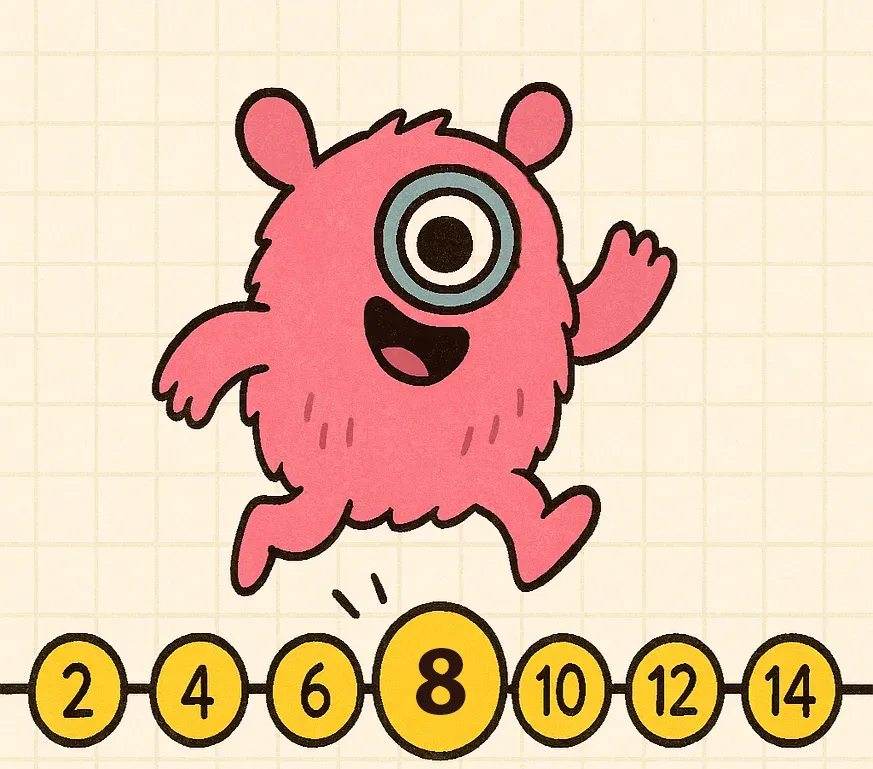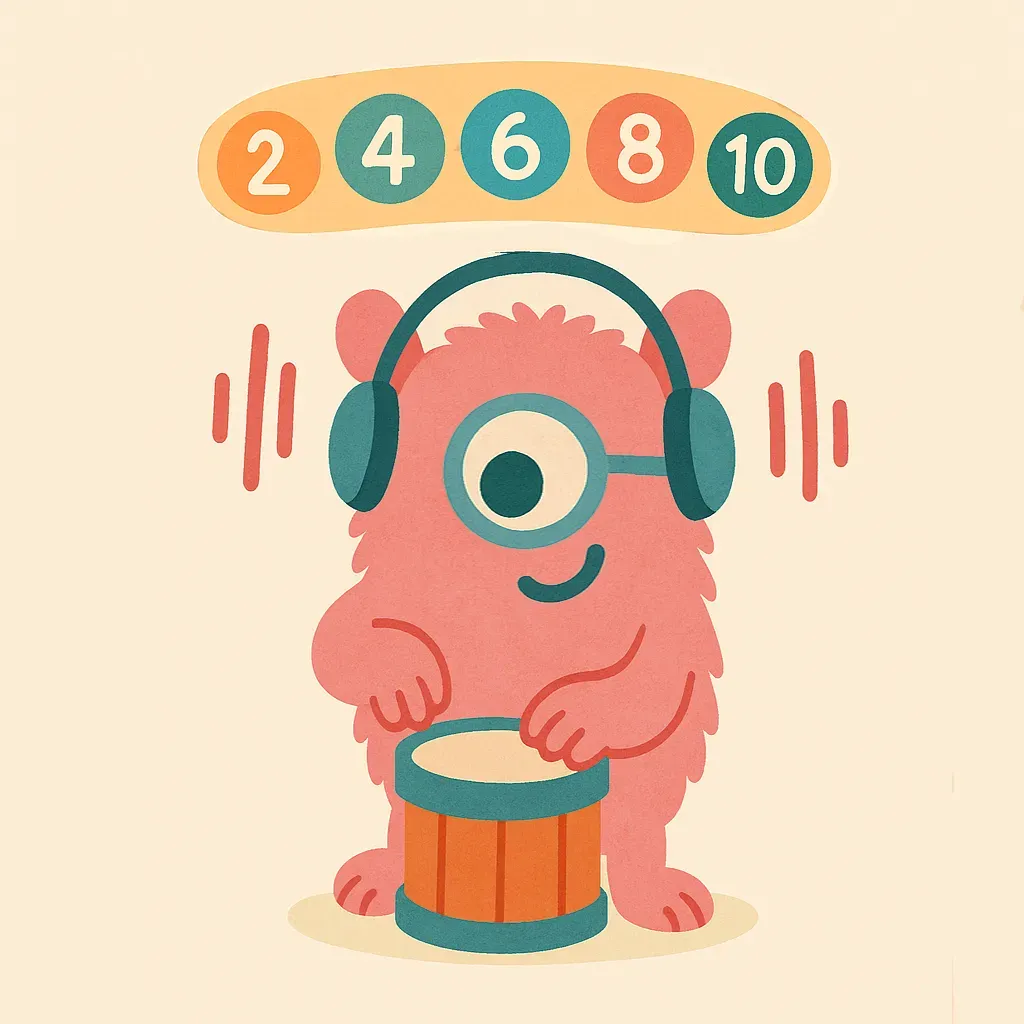Why Skip Counting Can Be a Lifeline for Dyscalculia Learners
TL;DR: Skip counting – the practice of counting by intervals (2, 4, 6, 8… instead of 1, 2, 3, 4…) – is more than just a fun math trick. For children with dyscalculia (a math learning disability), skip counting can be a crucial lifeline. Research shows it strengthens number sense, helps kids recognize numerical patterns, and builds a foundation for arithmetic fluency. Dyscalculia learners often struggle with basic counting and sequencing, but introducing skip counting through multisensory activities (like rhythmic counting, songs, or visual jump sequences) can bridge gaps in understanding. This article delves into why skip counting is so beneficial for dyscalculic students, backed by peer-reviewed research and practical strategies for parents and educators.
Understanding Dyscalculia and Counting Challenges
Dyscalculia is a neurodevelopmental disorder that impairs a child’s ability to understand numbers and mathematical concepts. It’s not simply “being bad at math” – rather, dyscalculia involves fundamental difficulties in number sense and processing numeric information. One hallmark of dyscalculia is trouble with basic counting and recognizing patterns in sequences. For example, a student with dyscalculia may laboriously count “1, 2, 3…” for every problem and struggle to predict what number comes next in a simple sequence. This includes difficulty with skip counting, i.e. counting by 2s, 5s, 10s, or any interval other than one. In fact, research finds that many dyscalculic learners cling to immature counting strategies (counting by ones) far longer than their peers (Brenda Ferrie, 2022). They have a hard time “counting on” from a given number or making jumps in sequences, indicating a breakdown in recognizing numeric patterns.
Why is counting such a hurdle? Fundamentally, children with dyscalculia often lack an intuitive number sense – an internal map of numbers and their relationships. In typical development, kids gradually move from counting each object one-by-one to more efficient strategies: they learn to skip count in larger groups, and eventually retrieve math facts from memory. Dyscalculic children, however, struggle to make this leap. They may continue relying on counting each item or finger-counting for even simple arithmetic, never transitioning to grouped counting or fact recall. This not only slows them down but also increases errors and frustration. As a result, tasks like skip counting (which require recognizing a progression or pattern) can feel nearly impossible without targeted support.
What Is Skip Counting and Why Is It Important?

Skip counting means counting forward or backward by a number other than 1. For instance, counting “5, 10, 15, 20…” is skip counting by fives. This skill might seem basic, but research highlights its fundamental role in math development. Educational studies indicate that skip counting bolsters children’s number sense, calculation fluency, and understanding of patterns. It effectively teaches kids to see numbers in groups (for example, perceiving 15 as three groups of 5) rather than as isolated units. This is especially vital for multiplication and division: skip counting lays the groundwork for knowing that 5, 10, 15, 20 are the multiples of 5, which in turn helps a child learn the 5× table. In essence, skip counting is an early exercise in recognizing math facts and sequences without having to memorize each fact in isolation.
For learners with dyscalculia – who often miss out on these pattern-recognition milestones – skip counting can serve as a conceptual bridge. It reinforces the idea of “composite wholes”, meaning the child learns that numbers can represent groups of items rather than just single objects. For example, when skip counting by 5s (5, 10, 15, 20…), a dyscalculic student begins to grasp that “15” isn’t just an abstract number to count up to, but also three groups of five. This awareness of grouping is a critical step toward understanding multiplication conceptually (Killion & Steffe 2002 via Cohen Jones 2012). Peer-reviewed research consistently emphasizes the importance of such counting competencies. A 2025 synthesis of 17 studies, for instance, found that interventions focused on counting skills (including activities like guided counting sequences and number patterns) produced moderate to strong improvements in early math outcomes for at-risk learners (Akther et al., 2025).
In short, skip counting is far more than a rote drill – it’s a gateway to higher-level math thinking, helping children move from counting “one-by-one” to thinking in chunks and intervals.
How Skip Counting Benefits Dyscalculic Learners
Why is skip counting considered a lifeline for students with dyscalculia? First, it directly addresses one of their core weaknesses: pattern recognition in numbers. Children with dyscalculia often find numerical patterns elusive. Skip counting provides a structured, repetitive pattern (e.g. always adding 2 or always adding 10) that can be easier to follow than variable sequences. Over time, practicing skip counting can improve a child’s ability to anticipate “what comes next,” strengthening the mental sequencing skills they struggle with. This builds confidence – instead of feeling lost in unpredictable numbers, the student has a roadmap to follow.
Secondly, skip counting can reduce the cognitive load during calculations. Dyscalculic learners often have limited working memory for numbers. Remembering multiple individual numbers or steps can overwhelm them.
Skip counting offers a shortcut: rather than keeping every counted number in mind, the child learns a sequence that gets them to the answer more efficiently. For example, to solve 8 + 8, a child who can skip count by 2s could go “2, 4, 6, 8, 10, 12, 14, 16” using four jumps of 2, instead of counting one-by-one from 1 to 16. This strategy uses fewer steps and is easier to track. In fact, research in math cognition notes that a common pathway for developing arithmetic proficiency is through increasingly efficient counting strategies (Fuchs et al., 2010). Learners who advance from counting in ones to counting in larger increments (and eventually to direct recall) show better gains in arithmetic fluency. Skip counting is a key rung on that ladder of efficiency.
Another benefit is that skip counting reinforces multiplication facts in a conceptual way. Many dyscalculic students struggle enormously with memorizing times tables – it can feel like an arbitrary list of numbers. Skip counting provides context and meaning to those facts. For instance, instead of trying to rote memorize that 4 × 5 = 20, a student practices counting by 5s (5, 10, 15, 20) and sees that 20 is the fourth number in the sequence. This approach leverages pattern recognition rather than pure memory. Educational experts often recommend teaching multiplication through skip counting first, before introducing memorization or drills. By using skip counting as a stepping stone, dyscalculic learners can gradually build a repertoire of known facts. Over time, repeated skip counting can even lead to automatic recall. As one review notes, systematic, guided practice in strategies like skip counting – combined with explicit feedback – helps students with math learning difficulties improve their fact fluency more effectively than drilling alone (Akther et al., 2025; Fuchs et al., 2010).
Lastly, skip counting can inject a bit of enjoyment and rhythm into math practice, which is valuable for learners who often associate math with failure or anxiety. Turning number sequences into a chant or game can alleviate some of the math anxiety dyscalculic children experience. Importantly, early success with skip counting (e.g. being able to count by 10s to 100) gives a much-needed confidence boost. Research shows that experiencing small wins in math can improve a child’s self-efficacy and openness to learning (Jansen et al., 2013). In practice, seeing that they can master counting by 2s or 5s helps dyscalculic learners feel “I can do this,” motivating them to tackle more complex tasks next.
Making Skip Counting Multi-Sensory and Fun
To truly serve as a lifeline, skip counting should be taught in a way that aligns with dyscalculic learners’ needs. What does that look like? Studies and specialist recommendations suggest a multi-sensory, structured approach is most effective. Here are some research-backed strategies for parents and educators to consider:
- Use Visual Aids: Anchor skip counting to visual patterns. Number lines, hundreds charts, or dot patterns can help children see the intervals.
For example, highlight every 5th number on a number line to visually map out skip counting by fives. Visual cues reduce working memory strain and help dyscalculic students grasp the concept of “skipping” numbers (KU study: visual cues ease working memory load). You can also use objects (like beads or counters) grouped in the skip-counting interval – e.g. groups of 2 or 10 – to make the pattern concrete. - Incorporate Movement: Engage the body to engage the mind. Movement-based learning is shown to benefit students with math learning difficulties by tapping into kinesthetic memory. Try having the child physically jump along floor markers labeled with skip-counting numbers (jumping to 2, 4, 6, 8…) or toss beanbags while chanting the sequence. This turns skip counting into a full-body experience and can improve retention (it’s also more fun than sitting and reciting). In our guide on building number sense for dyscalculic kids, we suggest activities like “floor number paths” where kids physically jump from one skip-counted number to the next, combining movement with counting practice.
- Add Rhythm or Music: Leverage auditory memory by using songs or rhymes for skip counting. Many children learn their 2s, 5s, or 10s through catchy tunes. For dyscalculic learners, this can be especially helpful – the rhythm acts as a scaffold for remembering the sequence. One educational program even incorporates music and rhythmic counting to reinforce skip counting for students with dyscalculia (Experts: use skip-counting songs in early grades). Clapping or using simple percussion while skip counting can similarly provide a rhythmic pattern that makes the counting sequence easier to follow and recall.

- Connect to Real-Life Contexts: Create opportunities to apply skip counting in everyday situations. This cements the concept beyond a rote exercise. For instance, count by 2s when sorting pairs of socks, count by 5s or 10s using nickels or dimes (money is great for showing groups of 5 and 10), or count plates by 2s when setting the table (“We have 3 people, so 2, 4, 6 – six plates in total”). Grounding skip counting in real objects and scenarios helps dyscalculic children see the practical value and meaning behind the numbers. It shifts skip counting from an abstract drill to a useful tool they can rely on.
- Gradual Progression and Explicit Teaching: Introduce skip counting step by step. Start with the easiest sequences (typically 2s), then move to 5s, 10s since they align with familiar patterns like our base-10 system and clock minutes. Then move to 9s and 4s (which are close to 10 and 5) and then finally 4s, 6s, 8s (which build on the 2s) and then 3s and 7s which are the hardest.
Each time you introduce a new skip-count sequence, model it first, practice together, and provide charts or reference tables the student can use. Dyscalculia learners benefit from explicit instruction and repeated reinforcement – they likely won’t pick up skip counting intuitively. Celebrate small victories (e.g. “You skip counted by 5s up to 50!”) to build confidence, and revisit older sequences frequently for reinforcement. The goal is to help the child internalize each pattern in their own time, without pressure.
By combining visual, auditory, and tactile elements, skip counting practice can engage multiple parts of the brain. This multi-sensory approach is a proven way to help neurodivergent learners form stronger mental connections (multi-sensory boosts retention; playful learning increases engagement). It also keeps learning interesting. A child who dreads traditional math drills might actually look forward to a skip counting game or song. The positive attitude that comes from these enjoyable experiences can further improve learning outcomes – when students are relaxed and having fun, they’re more receptive to absorbing new concepts.
Building Confidence Through Skip Counting
Confidence is a critical piece of the puzzle for dyscalculic learners. These children often face repeated failure in math class, which can chip away at their self-esteem and make them anxious about anything number-related (Merlo 2021 – impact of repeated failure). This is where skip counting can serve as an “academic lifeline” in more ways than one. Not only does it provide a concrete strategy to handle numbers, but it also creates moments of success that dyscalculic kids desperately need.
Read more about why your child needs Math Wins.
Think about the accomplishment a student feels when they can proudly recite the 10s (10, 20, 30…100) or count by 2s to 20 without error. For a learner who struggles with basic counting, this is huge. According to Dr. Daniel Ansari, a leading researcher in numerical cognition, nurturing a “growth mindset” and highlighting incremental progress is especially important for children with math learning disorders (see Jansen et al., 2013, on success reinforcing motivation). Skip counting exercises fit perfectly here: they are a tangible way to measure progress (more numbers reached, new sequences learned) and can be incrementally increased in difficulty as the child improves.
Furthermore, skip counting can act as a coping tool in higher math. As dyscalculic students advance in grade, they’ll encounter multi-digit addition, multiplication, and more complex calculations that still assume those basic facts. If a student hasn’t memorized their times tables (as many dyscalculic learners haven’t), being able to quickly skip count provides an alternative pathway to get the answer.
For example, if faced with 6 × 7, a student might not remember the product 42 outright, but if they can skip count by 6s or 7s, they have a method to arrive at 42 (like 7, 14, 21… up to 42). This can significantly reduce math anxiety because the child knows they have a fallback strategy – they don’t feel as helpless when memory fails. Psychologists note that having reliable strategies can reduce anxiety by improving a student’s sense of control and competence in learning situations (Merlo: anxiety from lack of control; math competence yields sense of control). In this way, skip counting is not only teaching math; it’s fostering resilience.
Finally, the benefits of skip counting aren’t limited to math class. The pattern recognition and grouping skills practiced in skip counting can translate to everyday life skills – from quickly counting money, to telling time (noticing the 5-minute marks on a clock), to estimating quantities. These are exactly the kinds of real-world tasks that individuals with dyscalculia find challenging. By continually reinforcing skip counting, parents and teachers are also equipping children with practical tools to navigate a world full of numbers, which can boost their independence and confidence outside of school.
FAQs
Q: My child with dyscalculia can barely count to 10. Isn’t skip counting too advanced?
A: Skip counting should be introduced only after a child is comfortable with basic counting from 1 to 10 and understands that numbers represent quantities. However, even simple skip counting (like by 2s or 5s with small numbers) can be started early with lots of visual support. The key is to make it hands-on and fun – use objects or drawings to illustrate the skips. Even if they need to count each interval at first, over time they’ll start internalizing the pattern. Go slow and celebrate progress (even counting 2, 4, 6 is progress!). It’s not too advanced if taught in a developmentally appropriate way.
Q: How does skip counting help with learning multiplication tables?
A: Skip counting is essentially a precursor to multiplication. Each skip count sequence is like “singing” a multiplication table. For example, skip counting by 3s (3, 6, 9, 12…) is the same as reciting the 3× table results. This helps dyscalculic learners see the connection between repeated addition and multiplication (Reys et al., 2012 on patterns). Instead of memorizing abstract facts, they follow a pattern to derive the facts. With practice, the pattern becomes familiar and the child may start recalling that 4 jumps of 3 equals 12 without counting it out. Thus, skip counting provides a conceptual route to mastering multiplication facts, which is much friendlier for a dyscalculic brain than rote memorization.
Q: My child can skip count by 5s and 10s easily, but struggles with 2s or 3s. Is that normal
A: Yes, this is very common. Counting by 10s and 5s can be easier because they form clear patterns (10s always end in 0; 5s alternate between ending in 5 and 0) and we encounter them often (e.g. 5s in clocks and money). Counting by 2s, 3s, or other numbers can be trickier and less intuitive. The fact that your child has mastered some sequences is a great sign – it means they can handle patterned counting. Continue to practice 2s and 3s with lots of supports: use pairs of objects for 2s, trios for 3s, and incorporate songs or stories. Over time, their brain will pick up the rhythm of those sequences too. Every child (with dyscalculia or not) finds some skip counts easier than others, so this is perfectly normal.
Q: Are there any tools or games to help with skip counting for dyscalculia?
A: Absolutely! Many resources are available to make skip counting engaging. You can find skip counting songs on YouTube for various numbers. There are also board games and card games designed for practicing sequences (for example, games where players hop spaces in multiples). Digital apps like Monster Math incorporate skip counting and other foundational skills into game play, which can be very motivating. Additionally, simple homemade activities work well: try a skip counting scavenger hunt (finding numbers around the house in order), or create a skip counting hopscotch in the driveway. The goal is to practice the skill in different formats. Our article on building number sense and our list of math games for dyscalculia include several ideas that involve skip counting in playful ways.
Q: When should we start teaching skip counting to a child with dyscalculia?
A: There’s no need to wait for a certain age or grade – introduce skip counting when the child understands basic counting and is comfortable recognizing numbers. Many kindergarten curricula introduce skip counting by 2s, 5s, and 10s in a very visual way (e.g. counting pairs of shoes by 2s, fingers by 5s, etc.). For a dyscalculic child, you might start a bit later or slower, but you can gently introduce the concept in first or second grade using concrete objects. The earlier they become aware of these patterns, the better, because you can reinforce it over years. Just be sure to keep it low-pressure and supportive. Early exposure, practice, and patience are key – even if mastery comes later, the familiarity will help.
Conclusion
For students with dyscalculia, math can feel like a relentless uphill climb. Skip counting emerges as one of those rare tools that offers immediate support while also building long-term skills. It meets learners where they are – often stuck counting in ones – and guides them toward more fluid and flexible thinking about numbers. By emphasizing patterns, grouping, and rhythmic learning, skip counting turns numbers into something a bit more manageable and a bit less scary. Crucially, it gives dyscalculic children a strategy they can pull out of their toolbox again and again, whether they’re adding up pencils, learning their times tables, or tackling word problems in middle school.
No single strategy will “cure” dyscalculia, but incorporating skip counting into daily practice can significantly improve a child’s numeracy. It builds a stronger foundation so that other math interventions (from number lines to manipulatives) can stand on solid ground. And perhaps just as importantly, it shows the child that math has order, rhythm, and sense – it’s not an arbitrary mess of figures designed to trip them up. With skip counting, we throw our dyscalculic learners a lifeline made of twos, fives, tens, or any number that helps them climb to the next level.
In the journey of supporting a child with dyscalculia, every little victory counts. And sometimes, those victories sound like “2, 4, 6, 8, 10…”.
References
- Akther, S. S., Powell, S. R., & Lariviere, D. O. (2025). Counting-Focused Intervention Effects for Students With Mathematics Difficulty: A Research Synthesis. Learning Disabilities Research & Practice, 40(2). (Findings indicate that interventions targeting counting skills – including one-to-one counting, stable order, etc. – yield moderate to strong improvements in early math proficiency).
- Dussŏpt, E., et al. (2019). The Diagnosis and Treatment of Dyscalculia. Dtsch Arztebl Int, 116(7), 107-114. (Clinical guideline outlining dyscalculia’s features, such as persistent counting-based strategies and difficulty learning math facts, and recommending early, targeted interventions).
- Pagliaro-Newman, D. (2024). Shining a Light on Dyscalculia. Edutopia. (Article discussing how dyscalculia impacts learning; notes that learners often struggle with patterns, skip counting, and sequencing, highlighting the need for specialized strategies).
- Victorian DEECD (2013). Early Numeracy Research Project – Mathematics Online Interview (Counting Section). (Department of Education & Early Childhood Development, Australia – emphasizes the importance of skip counting in developing fluency, number sense, and as a foundation for multiplication/division).
- National Numeracy (2022). What is dyscalculia and how can it be spotted and supported? Brenda Ferrie, BDA. (Explains that children with dyscalculia often remain stuck counting in ones and fail to develop efficient counting strategies like step counting, underscoring the importance of interventions that build number sense).
- Fuchs, L. S., et al. (2010). The effects of strategic counting instruction on number combination skill among students with mathematics difficulties. Journal of Educational Psychology, 102(3), 635-652. (Found that teaching efficient counting strategies improved addition/subtraction fact fluency in students with math difficulties, illustrating the benefit of moving from counting-all to skip-count or derived fact methods).

